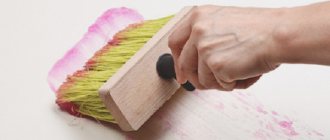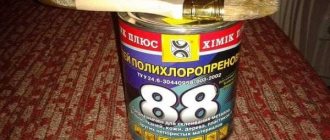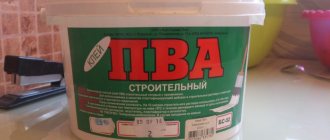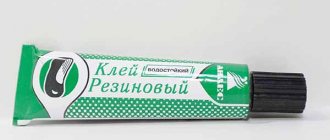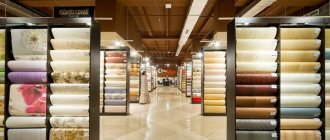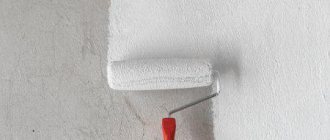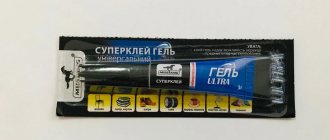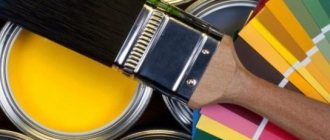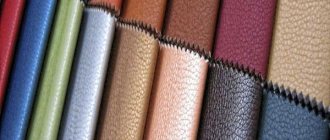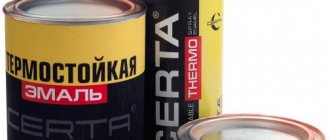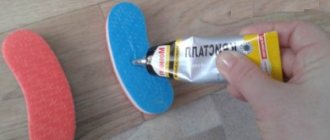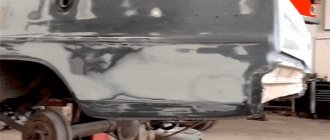Many believe that Russian-made goods are noticeably inferior to their European counterparts. This information can be heard both from specialists (it is no secret that the technology for using imported goods is often better thought out) and sales consultants in construction stores (their own benefit sometimes comes first for them). But the Russian construction market also has its own examples of high-quality products. Among them is KMC wallpaper glue. There are more than a dozen manufacturers of this brand of glue. And all their products meet high quality requirements.
Appearance of glue
If CMC is produced in accordance with the standards, it has a certain “appearance” and is distinguished by characteristic properties. This wallpaper glue is a white powder that is formed into small granules. It happens that the product turns yellow. In this case, the glue does not meet the technical requirements and does not have the declared properties. Typically, a yellow mass means low quality of the finished composition, a fake or a very expired powder.
You should not buy yellowed glue and, especially, try to glue wallpaper with it. Made without technology, it can not only contain harmful impurities, but can also ruin the wallpaper. As paper, thin or light-colored sheets are glued, yellow spots appear on them, and the repair has to be redone. Also, when purchasing, you need to pay attention to the uniformity of the powder: only this product, when diluted with water, forms an even, homogeneous mass without lumps.
Technical data
What technical characteristics does this glue have?
- It contains at least 57% of the substance in dry form.
- 21% sodium chloride powder.
- 69% is the active substance, taking into account the volume of the substance in dry form.
- Permissible humidity 12%.
- In new formulations, the powder will swell within 2 hours.
- In a week 4% usable. This means that it is best to wallpaper your walls when the mixture is fresh. The composition contains additives that will prevent rot in the paste and it has insecticidal properties. The composition is completely safe (there is a GOST) for human health.
If you want to make putty, you can add this powder to chalk and cement. This composition is also good for pasting a kitchen, bathroom, or toilet room with tiles.
Considering GOST, it becomes clear why this wide range of products is so popular in the domestic market. It is widely used by construction organizations and purchased by private owners for minor repairs. The cost of the glue is low, which only adds to its popularity among regular and potential customers. Manufacturers are interested in a fast and large turnover of products, therefore they keep the cost of goods low, which buyers are happy about.
GOST shows that the technical characteristics of the product are normal and there will be no problems during use. This wallpaper glue has an excellent composition with the necessary antiseptic additives. You won’t get poisoned by toxic fumes, you won’t accidentally stick your finger to the wall, everything is fine.
This is the composition, one of the classic ones, used for a long time.
Composition of the solution
Until recently, only one type of CMC glue was produced, the basis of which was carboxymethylcellulose, a product of cellulose processing (this substance in the abbreviation gave the glue its name). Now the product is produced by many domestic and even foreign brands, and each company includes various additives in it. Most often they are anti-caking agents and antifungal substances (fungicides):
- hydroxybenzene,
- potassium sulfate,
- aluminum sulfate,
- borax (sodium tetraborate),
- carbolic acid.
These substances, despite their synthetic origin, are not harmful to the body. They are especially important for cases where the walls have lost their ability to “breathe” when gluing vinyl or other durable wallpaper. Thanks to antiseptics and fungicides, fungus and mold will not grow on the walls.
How to make tile adhesive with your own hands - recipe
It is very important to know the approximate composition of tile adhesive if you want to make it yourself. Of course, the easiest way is to buy it in a specialized store, but what to do if work is in full swing, and all construction stores are no longer open? This is precisely when understanding how to make tile adhesive yourself according to a recipe will come in handy
First, make sure you have the basic glue ingredients:
It is in this case that understanding how to make tile adhesive yourself according to a recipe will come in handy. First, make sure you have the basic glue ingredients:
- Cement – brand M-400 is suitable.
- Sand.
- Wallpaper glue or regular PVA glue.
Naturally, we will also need containers for mixing the components, as well as various tools. The manufacturing process will look like this:
First you need to dilute the wallpaper glue with the amount of water indicated on the package
Remember that maintaining proportions is very important for the correct consistency of the glue; Next we need sand. You can buy it at a hardware store, telling the seller that you need sand, the fractions of which should be about 2 mm
If required, sift the sand; then mix sand and cement. Here you also need to observe proportions: one part of cement will require three parts of sand; Our task in preparing glue is to achieve the consistency of thick sour cream. That is why diluted wallpaper glue should be added to the cement-sand mixture in portions. First, you can pour in one glass, then stir the solution and, if necessary, pour in more wallpaper glue; then you can move on to testing. We apply the composition to the tile, and then apply it to the surface. If the glue adheres well to it, and it is of sufficient consistency to allow you to move the tiles along the wall, then we have done everything right.
If something doesn’t work out, then the required consistency can be achieved by adding a dry mixture or water.
For more information about making homemade glue, watch the video:
https://youtube.com/watch?v=AtpUUeQ6UoU
Eunice
Eunice tile adhesive is in quite high demand, which is explained by its decent hardening characteristics, as well as its quite affordable cost.
So, a 25-kilogram bag will require about five liters of liquid.
Eunice
The adhesive is applied to the tiles in a layer of approximately 1.5 cm, which allows you to use it quite economically. On average, 4 kg of mixture is used per square meter.
Remember that after preparing the glue, it must be used within 4-5 hours, otherwise it will lose all its properties.
Main characteristics
There may be different manufacturers of glue, but the average technical parameters of the finished product are respected by everyone. The most important characteristics of the glue:
- the share of main dry matter in the composition is 57%,
- the proportion of active substance in relation to the total amount of dry matter is 6%,
- the proportion of sodium chloride from the total amount of dry matter is 21%,
- the proportion of moisture in the glue is 12%,
- degree of substitution of carboxymethyl groups – 65-85,
- solubility – 96% (minimum),
- pH of aqueous solution 1.5% – 8-11,
- shelf life of the 4% solution is 7 days,
- the time for swelling of the mass to homogeneity is up to 2 hours.
Types, composition and technical characteristics of wallpaper adhesives
Chemical enterprises produce their own type of CMC for different types of wallpaper. The features of each are indicated on the label or packaging. In any composition, the base substance must be at least 50 percent, and the proportion of sodium chloride must be 21 percent. The humidity of the mixture is up to 12 percent. The solubility of the powder is 96 percent.
CMCs differ in composition and percentage of carboxymethylcellulose. Almost all manufacturers produce universal adhesive that can be used for gluing all types of wallpaper. For each finishing material, its own solution is prepared, in which water is taken in larger or smaller quantities.
For light thin wallpaper
For the thinnest paper wallpapers, it is recommended to use KMC Burny, KMC-N, KMC-1 (Shavings). The form of glue is a white or pink powdery substance, without any odor. Before use, the powder is diluted in water according to the instructions for use. The adhesive solution applied to the surface takes a long time to dry. During the renovation period, make sure that there are no drafts in the room.
Medium weight
Non-woven wallpaper is considered slightly heavier than paper wallpaper. For their gluing, CMC-N or CMC-N Super-Max, Mini-Max, Extra Fast are used. This product is a powder of small granules. The packaging must indicate the type of wallpaper for which the adhesive is used. Any glue is diluted with water according to the instructions.
Thick heavy wallpaper
Inyl wallpaper is considered the heaviest. To cover surfaces with thick wallpaper, use CMC Super Strong. In sTo cover the surface with thick wallpaper, use CMC Super strong. PVA glue is sometimes added to the remainder of the adhesive composition. Externally, glue for heavy wallpaper looks like a white fibrous mass. Before use, the product is diluted with water in the dosage specified in the instructions.
Application area
Most often, the product is used for its intended purpose - for wallpaper as wallpaper glue. Depending on the variety, it can be used on paper and non-woven, thin and thick, durable vinyl wallpaper and photo canvases. CMC can also be added to other solutions to increase their strength and adhesive properties. We are talking about tile adhesive, chalk and cement putties.
There are other areas where glue has found application:
- textile production,
- production of drilling glue for the oil and gas industry,
- mining ore,
- creation of ceramic products (as a binder),
- production of matches, durable paper with an adhesive layer, household detergents,
- production of varnishes, paints, including facade, water-dispersion,
- production of artificial fur,
- various biological studies and experiments.
Glue VK-9
Glue VK-9 PI 1.2A.526-99 TU 1-595-14-842-2004, GOST B 84-2081-83
Designed for gluing steels, aluminum and titanium alloys, to each other and to non-metallic materials. For radio engineering products and adhesive threaded connections. It looks like a viscous-flowing gray mass. Highly elastic and high-strength film adhesives.
The use of high-strength adhesives ensures the creation of structures with a high service life and operational reliability. Adhesive joints have high long-term strength, vibration resistance, resistance to fatigue crack propagation, exposure to climatic factors and aggressive environments. The strength of adhesive joints when tested in shear ranges from 25 to 40 MPa, and when peeled, from 3 to 12 kN/m. Tensile elongation from 40 to 200%. This variety of properties of structural adhesives allows the product developer to select adhesives for glued structures depending on the requirements for the adhesive joint.
The main adhesives for the manufacture of power structures of modern aircraft are adhesives VK-25, VK-36, VK-41, VK-46, VK-50, VK-51, VK-51A and their modifications. VK-25 adhesive (liquid) is used for the production of honeycomb core from AMg2-N aluminum foil and polymer paper. Film adhesives VK-25, VK-51A and VK-50 are intended for the manufacture of layered load-bearing structures made of metals and PCM, operating under conditions of increased fatigue and acoustic loads. Film adhesives VK-41, VK-36, VK-51 and their modifications are intended for gluing metals and non-metallic materials in the manufacture of honeycomb structures.
Paste adhesives VK-9, VK-27, VK-57 and VK-67 are used for the manufacture of adhesive and adhesive-mechanical (glued, adhesive-threaded, etc.) joints, including for the slipway assembly of aircraft airframes. They cure at room temperature, have a range of operating temperatures: - from -60 to +125°C for a long time, at 200°C - 500 hours; at 250°C - 5 hours (adhesives VK-9, VK-57, VK-67); - from -60 to +80°C for a long time and at 250°C for a short time (VK-27 glue).
Composition: Glue VK-9 (PI 1.2A.526-99) is a two-component cold-curing epoxy composition. Consisting of epoxy and polyamide resins modified with organosilicon compounds and mineral fillers (asbestos, boron nitride, titanium dioxide, etc.). Application: Glue VK-9 (PI 1.2A.526-99) is intended for adhesive, glue-welded and glue-threaded joints made of steel, aluminum, magnesium and titanium alloys, non-metallic materials in structures operating from minus 60C to plus 125C for a long time, at plus 200C - 500 hours and at plus 250C - 5 hours. Packaging: VK-9 adhesive (PI 1.2A.526-99) is supplied in metal or plastic containers in sets of 1 and 5 kg or packaging at the customer’s request. Transportation: VK-9 glue (PI 1.2A.526-99) is transported by road or rail in accordance with the rules for the transportation of goods. Storage: The guaranteed shelf life of VK-9 Glue components (PI 1.2A.526-99) at room temperature is 12 months.
Name of indicator Norm according to instructions
Appearance A homogeneous viscous mass from gray to white (depending on the filler) without foreign inclusions. Viability at +(15-20)C, h 2.5 Shear strength of adhesive joints of anodized D16AT alloy, kgf/cm2, not less at: -20C-80C-125C
1405545
Types of CMC glue
Conventionally, all types of adhesives are divided into those used for light, medium and heavy wallpaper. As for specific products, the following types of CMC can be found on sale:
- KMC-1 Chips. Used for gluing paper wallpaper, as well as light washable fabrics.
- KMC-1. Suitable only for paper wallpaper.
- KMC-N. Suitable for medium and light wallpaper on paper and textile bases.
- KMC-N SuperMax. Can be used for any wallpaper when gluing to concrete or plastered substrates.
- KMC-N MiniMax. Glue for washable wallpaper.
- KMC Extra Fast. Can be diluted for priming walls. Suitable for wallpapering concrete, plaster, dries quickly.
Some brands produce CMC with the addition of PVA. This product is suitable for covering walls with the strongest, heaviest canvases; it holds them securely without deformation. Important condition: wallpaper should be glued to any non-metallic base, as well as to unpainted surfaces. It does not adhere well to the latter and has a low degree of adhesion. Some adhesives additionally contain color indicators that allow you to assess which part of the canvas the product has already been applied to. After drying, these dyes lose color.
Types, how to choose
The color of a product is an important characteristic; you should pay attention to it when choosing a product in a store. Glue powder, produced in accordance with GOST standards, is pure white. This product is characterized by excellent quality; when combined with water, it forms a homogeneous mixture without sediment or lumps.
A yellow tint is not acceptable. He usually says that the glue is made in a homemade way by unscrupulous manufacturers. A product like this has the same quality. They usually do not meet the standards of adhesive work, so the result can be very disappointing. For example, after drying, unpleasant yellow stains will appear on paper wallpaper, which can no longer be removed, and you will have to repeat all the work of gluing the wallpaper.
Advice! Despite the large selection of this glue in hardware stores, be sure to carefully study the product before purchasing. Pay special attention to its color.
If we approach the description of CMC glue from the point of view of its purpose, then it is divided into three main groups:
- for installation of light thin wallpaper;
- for medium weight wallpaper;
- for thick, heavy wallpaper.
The thickness and stickiness of the mixture and, as a result, the ability to firmly attach heavy webs, directly depends on the amount of the main substance in the powder - carboxymethylcellulose. If there is a lot of it, then the solution is more viscous, and even heavy vinyl wallpaper will stay securely on the wall.
Advantages and disadvantages
Glue has many advantages. It is absolutely transparent, and after finishing the work there will be no unsightly stains left on the wallpaper. The product does not have an unpleasant odor, is harmless to the skin and respiratory system, and can be used in children's institutions. It is very easy to dilute, it practically does not form lumps. Other advantages of glue:
- compatibility with other means, suitability for addition to building compositions,
- reliability and environmental friendliness,
- no need for heat treatment,
- protection against fungus, mold, insect infestation,
- economical in price, low consumption,
- complete swelling without the appearance of sediment,
- gluing to most types of surfaces,
- Possibility of use in rooms with high humidity.
The product has a drawback - it needs to swell for about 2 hours, which is quite a long time for wallpaper glue. But some manufacturers have already eliminated this disadvantage: modern formulations require complete dissolution in 10-15 minutes, although the price of such adhesives will be higher.
Varieties
CMC is a universal adhesive. It can easily stick wallpaper to any type of substrate and density.
What’s good is that the glue can be used for vinyl, paper, acrylic, and fabric.
In addition to the universal CMC, you can also find such types of glue as:
For light fabrics – KMC Lux, KMC-N Mini-Max.
An economical option is KMC-N.
For plastered and concrete bases – Extra Fast, Super Max.
There is also CMC with the addition of PVA glue. It is great for paper wallpaper, which can be fixed to wood, concrete, plastered and other substrates. This composition does not last long on painted surfaces.
Each type of glue has unique additives that give the glue special properties. More information about this can be found directly on the packaging of a separate CMC.
Reference! When choosing glue, it should be taken into account that the thicker the canvas, the thicker the prepared solution should be.
Some CMC adhesives contain an indicator. Upon contact with water, the glue changes color and becomes transparent after drying. This property allows you to control the application.
How to prepare glue correctly - procedure
All manufacturers describe in detail the method of diluting the glue so that the user strictly follows the proportions of its dilution with water. The method for creating the adhesive mass is as follows:
- prepare dishes of sufficient volume (usually a plastic bucket with a lid is used),
- heat the water to +25 degrees (room temperature),
- pour water into a bucket, having previously measured it, then add glue in portions,
- Mix the composition thoroughly as it pours out,
- When adding all the adhesive powder, mix the product again,
- leave to infuse under the lid (for 2 hours).
Typically, when preparing a solution, manufacturers indicate the following proportions: for 500 g of glue - 8 liters of water. If the fabrics are dense, the amount of water is reduced to 7 liters.
What types of wallpaper glue are there?
Modern wallpaper adhesives are convenient when preparing for work. It is enough to pour the glue into water at room temperature with quick stirring, and after 3, maximum 15 minutes, the glue is ready for use. Gone are the days when you had to soak the glue, bring the mixture to a boil, and then wait for it to cool.
In terms of composition, the glue is available in two types: CMC glue, based on cellulose, and glue based on modified starch.
CMC glue
CMC glue has good adhesive properties. The glue is ready for use no less than three hours after mixing it with water. It has relatively low consumption and low price. A package of CMC glue weighing 500 grams is enough to cover 50 m². The price of a pack is 50-60 rubles.
KMC glue is suitable for gluing any types of wallpaper. For light wallpaper, take 8 liters of water per 500 grams of glue, for heavy and dense wallpaper, prepare thicker glue - 500 grams per 7 liters of water. CMC glue is diluted in warm water and left to swell for 3-8 hours. The swelling time is indicated on the packaging. With such a long time to prepare the glue, it is better to soak it overnight. You soak it in the evening and in the morning the glue is ready for use. Wallpaper glued with CMC glue is difficult to remove during subsequent repairs.
Starch-based adhesive for various types of wallpaper
Based on modified starch, glue is produced for each type of wallpaper. The composition of the glue differs in additives, but the adhesive base is starch, which is an environmentally friendly product. When wallpapering in damp rooms, choose an adhesive that contains antifungal additives.
According to their intended purpose, starch-based wallpaper glue is produced in the following categories:
- Adhesive for paper wallpaper - suitable for all types of paper wallpaper and light vinyl.
- Vinyl wallpaper adhesive - used for thick vinyl wallpaper. Many manufacturers add methylcellulose to the composition of such glue.
- Universal glue - used for all types of wallpaper.
The packaging of universal glue indicates in what proportions the glue should be diluted. For paper wallpaper, the glue is diluted to a liquid consistency. This is necessary to quickly soak the paper base of the wallpaper. Thick glue is difficult to apply evenly on thin wallpaper; after drying, unevenness may form on the wallpaper.
For heavy wallpaper, the glue should be thicker and more viscous than for light paper wallpaper.
4. Glue for non-woven wallpaper. Contains antifungal additives. Glue is applied to the wall.
5. Glue for glass wallpaper. Also suitable for gluing non-woven wallpaper. In addition to modified starch, the composition includes methylcellulose.
Production Standards
GOST regulates only the production of the main component of the product - carboxymethylcellulose. The actions of GOST 30535-97 “Polymer adhesives” and GOST 7698-93 “Starch” do not apply to the production of CMC glue. The actual KMC glue is produced in accordance with TU 2231-034-07507908, TU 6-55-40-90 and other technical conditions, which may vary depending on the specific manufacturer.
Features of use
There is nothing complicated in the procedure for preparing wallpaper adhesive and anyone can handle it. But still, I would like to describe this process in detail so that no questions arise during the work.
First of all, the mixing container is prepared. An enamel bucket or basin is suitable as a container. Then you become familiar with the mixing recommendations, which are indicated on the packaging of CMC glue. Typically, for light fabrics, 500 grams of dry matter and 8 liters of water are taken. For thicker canvases you will need the same amount of dry glue and 7 liters of water to prepare the composition.
Important! Water should only be at room temperature.
Next, the master pours the powder into water with constant stirring. For the composition to swell, you need to wait an average of 3 hours.
You can learn about glue consumption from the information presented on the packaging. But usually a pack of 500 grams is enough to prepare a solution, which will be enough to paste a room with an area of 50 square meters.
When purchasing, you should select the CMC that, according to the technical data, will correspond to the selected type of wallpaper.
Manufacturers of CMC glue
The market offers products of domestic and imported brands. Usually the price of the former is much cheaper, the technical characteristics are good. Imported products are more expensive, but they are also of better quality. The leader among glue manufacturers is Vympel, a company based in the Moscow region. CMC is also produced by Omega, Politsell, and Malva. CMC "Burny" glue produces a product in small packages of 200 g - , adhesive for drilling rig wallpaper based on CMC - . Also on the list of glue manufacturers are Polyex-Siberia, OTK, Bytkhim.
Advantages and main manufacturers of CMC
In addition to the already mentioned advantages (versatility, extreme simplicity in diluting the powder, reliability, protection against microbes and mold), CMC wallpaper adhesive has the following advantages:
- the appearance of stains and stains on the surface of the wallpaper is excluded;
- the repulsive odor is completely absent;
- the glue is very easy to prepare and use;
- the product is successfully combined with other chemical compounds.
Products of this kind, both domestic and foreign, are widely represented on the building materials market. Russian CMC glue has distinctive features, such as an affordable price and satisfactory characteristics. At the same time, it usually swells in 2 hours, which is acceptable from the point of view of the GOST standard.
The cost of foreign-made products is much higher. At the same time, the solution is prepared faster; after 15 minutes after dilution, it can already be used for wallpapering.
Undoubtedly, one of the most popular manufacturers of KMC wallpaper adhesive in Russia is Vympel Trade Center LLC, operating in the Moscow region. All its products are provided with the necessary certificates.
